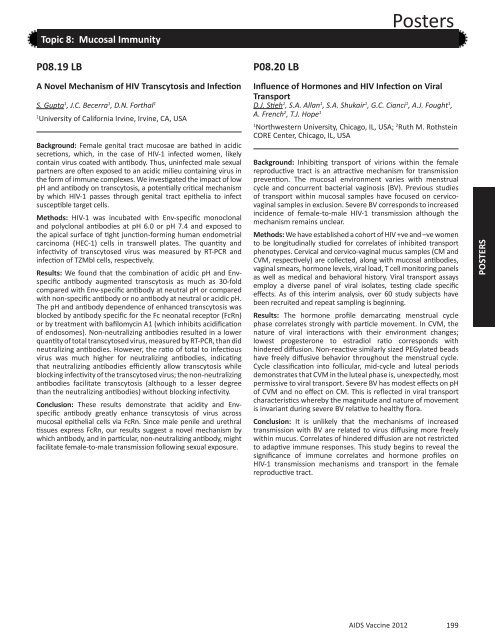Oral Abstract Session 01 - Global HIV Vaccine Enterprise
Oral Abstract Session 01 - Global HIV Vaccine Enterprise
Oral Abstract Session 01 - Global HIV Vaccine Enterprise
You also want an ePaper? Increase the reach of your titles
YUMPU automatically turns print PDFs into web optimized ePapers that Google loves.
Topic 8: Mucosal Immunity<br />
P08.19 LB<br />
A Novel Mechanism of <strong>HIV</strong> Transcytosis and Infection<br />
S. Gupta 1 , J.C. Becerra 1 , D.N. Forthal 1<br />
1 University of California Irvine, Irvine, CA, USA<br />
Background: Female genital tract mucosae are bathed in acidic<br />
secretions, which, in the case of <strong>HIV</strong>-1 infected women, likely<br />
contain virus coated with antibody. Thus, uninfected male sexual<br />
partners are often exposed to an acidic milieu containing virus in<br />
the form of immune complexes. We investigated the impact of low<br />
pH and antibody on transcytosis, a potentially critical mechanism<br />
by which <strong>HIV</strong>-1 passes through genital tract epithelia to infect<br />
susceptible target cells.<br />
Methods: <strong>HIV</strong>-1 was incubated with Env-specific monoclonal<br />
and polyclonal antibodies at pH 6.0 or pH 7.4 and exposed to<br />
the apical surface of tight junction-forming human endometrial<br />
carcinoma (HEC-1) cells in transwell plates. The quantity and<br />
infectivity of transcytosed virus was measured by RT-PCR and<br />
infection of TZMbl cells, respectively.<br />
Results: We found that the combination of acidic pH and Envspecific<br />
antibody augmented transcytosis as much as 30-fold<br />
compared with Env-specific antibody at neutral pH or compared<br />
with non-specific antibody or no antibody at neutral or acidic pH.<br />
The pH and antibody dependence of enhanced transcytosis was<br />
blocked by antibody specific for the Fc neonatal receptor (FcRn)<br />
or by treatment with bafilomycin A1 (which inhibits acidification<br />
of endosomes). Non-neutralizing antibodies resulted in a lower<br />
quantity of total transcytosed virus, measured by RT-PCR, than did<br />
neutralizing antibodies. However, the ratio of total to infectious<br />
virus was much higher for neutralizing antibodies, indicating<br />
that neutralizing antibodies efficiently allow transcytosis while<br />
blocking infectivity of the transcytosed virus; the non-neutralizing<br />
antibodies facilitate transcytosis (although to a lesser degree<br />
than the neutralizing antibodies) without blocking infectivity.<br />
Conclusion: These results demonstrate that acidity and Envspecific<br />
antibody greatly enhance transcytosis of virus across<br />
mucosal epithelial cells via FcRn. Since male penile and urethral<br />
tissues express FcRn, our results suggest a novel mechanism by<br />
which antibody, and in particular, non-neutralizing antibody, might<br />
facilitate female-to-male transmission following sexual exposure.<br />
P08.20 LB<br />
AIDS <strong>Vaccine</strong> 2<strong>01</strong>2<br />
Posters<br />
Influence of Hormones and <strong>HIV</strong> Infection on Viral<br />
Transport<br />
D.J. Stieh 1 , S.A. Allan 1 , S.A. Shukair 1 , G.C. Cianci 1 , A.J. Fought 1 ,<br />
A. French 2 , T.J. Hope 1<br />
1 Northwestern University, Chicago, IL, USA; 2 Ruth M. Rothstein<br />
CORE Center, Chicago, IL, USA<br />
Background: Inhibiting transport of virions within the female<br />
reproductive tract is an attractive mechanism for transmission<br />
prevention. The mucosal environment varies with menstrual<br />
cycle and concurrent bacterial vaginosis (BV). Previous studies<br />
of transport within mucosal samples have focused on cervicovaginal<br />
samples in exclusion. Severe BV corresponds to increased<br />
incidence of female-to-male <strong>HIV</strong>-1 transmission although the<br />
mechanism remains unclear.<br />
Methods: We have established a cohort of <strong>HIV</strong> +ve and –ve women<br />
to be longitudinally studied for correlates of inhibited transport<br />
phenotypes. Cervical and cervico-vaginal mucus samples (CM and<br />
CVM, respectively) are collected, along with mucosal antibodies,<br />
vaginal smears, hormone levels, viral load, T cell monitoring panels<br />
as well as medical and behavioral history. Viral transport assays<br />
employ a diverse panel of viral isolates, testing clade specific<br />
effects. As of this interim analysis, over 60 study subjects have<br />
been recruited and repeat sampling is beginning.<br />
Results: The hormone profile demarcating menstrual cycle<br />
phase correlates strongly with particle movement. In CVM, the<br />
nature of viral interactions with their environment changes;<br />
lowest progesterone to estradiol ratio corresponds with<br />
hindered diffusion. Non-reactive similarly sized PEGylated beads<br />
have freely diffusive behavior throughout the menstrual cycle.<br />
Cycle classification into follicular, mid-cycle and luteal periods<br />
demonstrates that CVM in the luteal phase is, unexpectedly, most<br />
permissive to viral transport. Severe BV has modest effects on pH<br />
of CVM and no effect on CM. This is reflected in viral transport<br />
characteristics whereby the magnitude and nature of movement<br />
is invariant during severe BV relative to healthy flora.<br />
Conclusion: It is unlikely that the mechanisms of increased<br />
transmission with BV are related to virus diffusing more freely<br />
within mucus. Correlates of hindered diffusion are not restricted<br />
to adaptive immune responses. This study begins to reveal the<br />
significance of immune correlates and hormone profiles on<br />
<strong>HIV</strong>-1 transmission mechanisms and transport in the female<br />
reproductive tract.<br />
199<br />
POSTERS


